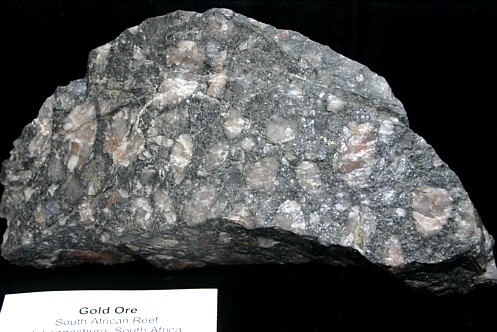Perhaps the most remarkable goldfield on the planet is found in the Witwatersrand district of South Africa. The connected chain of mines that lies east and west of Johanesburg has produced a considerable portion of the world’s gold. It is estimated that about 1,565 million ounces of gold were produced from the conglomerate beds (reefs) in the Witwatersrand basin between 1886 and 2000. This vast amount is close to 40 percent of all the gold mined on earth during the recorded history of mankind. Although the gold mining industry on the Witwatersrand began to decline many years ago, the Witwatersrand basin remains by far the most important known gold-producing province. For many decades, the production of the Witwatersrand district alone far exceeded the whole output of the next most productive gold mining country - the United States, with its numerous rich fields, vein and placer. The Witwatersrand mines are spread along a belt for some 62 miles, from Randfontein on the west to Holfontein on the east. Of this distance a length of some 12 and 1/4 miles near Johannesburg yields 76 percent of the gold won. The conglomerate beds have, however, been proved by outcrops and by borings for 164 miles; their continuity is concealed for 123 miles, and is interrupted by faults and dykes for 31 miles, making a total of 308 miles of actual and of probable extension. The district derives its name from a ridge (the Witwatersrand) that rises a few hundred feet above the general level (5,500 feet) of the plateau or High Veldt, and forms, indeed, the main divide between streams flowing to either the Indian or the Atlantic Oceans. The range or rather ridge, in conformity with the strike of the underlying strata, has a general east and west trend. It, as well as the High Veldt in the neighborhood, carried a very scanty arboreal vegetation that speedily disappeared with the advent of the miners.
Panning of auriferous quartz veins in the region was reported as early as 1852, but the presence commercial quantities of gold in the Witwatersrand appears to have been discovered on the farm Langlaagte by one Arnold in 1885, and a small five stamp mill battery was shortly afterwards erected on the spot. It was soon found that the gold was confined to the conglomerate outcrop which was even then traced for many miles. To it was given the term “banket," of Boer origin, and signifying almond-rock, owing to the fancied resemblance of the white quartz pebbles within the brown oxidized matrix to the almonds in that confection. In 1886, several farms were proclaimed open to mining, and in the same year a great "gold rush" set in towards the Witwatersrand. Johannesburg was marked off. It owed its name to the circumstance that each of the four Boer dignitaries who selected the town-site owned the prenomen of Johannes. A boom, speedily followed by the inevitable panic, took place early in 1899, and for four years the Rand, as it is familiarly known, was looked on with some disfavor. The steady development of the reefs during the period of depression and more especially the steadily increasing gold-yield brought about a complete restoration of confidence. In 1895-6 a considerable amount of British and foreign capital was invested. The mine returns and share values alike increased until the declaration of war towards the end of 1899. More or less steady work was resumed in 1902, the richer patches and mines having been during the war spasmodically worked by the Boer Government. In 1904 the annual yield exceeded by 44,000 ounces the highest previous return, and for many decades each succeeding year showed a material increase. Additional Mines, not on the northern limb of the Witwatersrand syncline and not in the immediate vicinity of Johannesburg are distributed over the goldfields of Heidelberg, Klerksdorp, Barberton, Lydenburg, and Pietersburg, with a few minor fields.
In a typical section across the Central Rand, the Main Reef Series consists of three workable beds of conglomerate named, in ascending order, the Main Reef, the Main Reef Leader, and the South Reef. Other, but non-payable, conglomerate bands are found in some mines within the Main Reef series, viz., the North Reef, some 30 feet below the Main Reef ; the Middle Reef, between the Main Reef Leader and the South Reef ; and the South Reef Leader, about 2 feet below the footwall of the South Reef. The Livingstone, Bird Reef, and Kimberley Series of similar conglomerates are of no present economic value. The Elsburg Series, consisting of the usual alternations of conglomerate and quartzite, succeeds the thick quartzites lying above the Kimberley Series. Whether they do so conformably is, however, a moot point. The balance of evidence appears to be in favor of an unconformity. The Elsburg Series contains gold, but not in sufficient quantities to warrant mining operations on it. During the deposition of the conglomerates and quartzites of the Witwatersrand System, laid down contemporaneously with them (as is perhaps proved by the presence of amygdaloids) extensive flows of diabase. These are especially well developed in the Eastern Rand, where one flow, lying over the Bird Reef Series, reaches a thickness of 150 feet. Basic dykes, intrusive through the Witwatersrand Beds, are numerous. They include norites and diorites. Above the rocks of the Ventersdorp System there occur, the Black Reef, Dolomite, and Pretoria Series of the Potchefstroom System. Of these the Black Reef Series is auriferous, but has been little worked except at Klerksdorp.
The Witwatersrand Beds are irregularly exposed over an area 180 miles long from east to west, and 100 miles broad from north to south. The Johannesburg mines are situated towards the north-eastern corner of this area, where the older beds have been exposed along a north-east to south-west anticlinal axis by the denudation of the Dolomite and Black Reef Series. Passing south-west from Krugersdorp along the strike of the beds, the end long pitch of the anticlinal axis is found to carry the older beds beneath the Black Reef and Dolomite Series to reappear again some 16 miles east of Ventersdorp, as a wrapping round an Archaean granitic mass in the High Veldt. Here the sedimentary beds dip away from the granite, certainly on the north and east, and possibly also on the south-west. The south-eastern limb of this anticline, or, as it may more conveniently and simply be termed, the north-western limb of the main syncline, extends from Klerksdorp in the south-west to Boksburg in the north-east. The south-eastern synclinal limb is not so well defined as the preceding, but is nevertheless strongly exposed in the Heidelberg and Venterskroon districts, disappearing beneath younger beds along the Vaal River in the neighbourhood of Vereeniging.
The auriferous conglomerates of the Nigel Series in the Heidelberg district have been definitely identified with the Van Ryn Reef Series the eastern continuation of the Main Reef Series beyond the Boksburg break. The most easterly exposure of the Witwatersrand beds is near Springs, but they have been proved by boreholes to continue a little farther east beneath the overlying strata. The dip of the Main Reef Series varies with the position of the cross-section. In most cases it is more than 45, and may reach 75, especially near the outcrop, but in depth it shows a decided tendency to flatten, and in the deeper mines the average dip is probably slightly less than 30. The typical "banket" is composed of fairly well rounded pebbles and small boulders of quartz and quartzite of an average diameter of perhaps 1 to 2 inches, together with more angular and elongated fragments of slate and chert. From the general shape and disposition of the pebbles it is taken that they were deposited on marine beaches, and are not river-laid conglomerates. The pebbles are embedded in a siliceous cement made up of quartz grains that are themselves cemented by siliceous impregnations, making a mass so compacted that fracturing takes place often with greater ease across than around the pebbles.
Most of the gold occurs together with rounded pyrite and uraninite, and in places with bituminous carbon, along degradation surfaces in coarse grained siliciclastic rocks of the West Rand Group, and more importantly, in similar rocks of the Central Rand Group. The gold occurs in the siliceous cement in exceedingly fine, irregular, angular particles rarely visible to the naked eye. It is often associated with, and is found resting on, crystals of pyrite. In many cases rounded particles of pyrite may be bounded by gold particles. The rounded grains and small masses of pyrite are of interest, since they simulate rounded water-worn fragments, and have, indeed, on that account, given rise to the theory of a placer origin for the pyrite as well as for the gold of the blanket. No original gold grains, or, to be precise, only a few exceedingly minute particles, have been found within the pebbles of the conglomerate, though numerous instances are recorded of secondary auriferous deposition along fracture planes within the pebbles Few questions relating to the deposition of gold have, of late years, been more keenly discussed than the origin of the gold of the Witwatersrand conglomerate. Various theories have from time to time been advanced to account for its widespread presence throughout the cement of the conglomerate in such relatively large quantities. Of these, two only have survived and alone demand consideration in this place. The first is the hypothesis of placer origin, which assumes that the gold is contemporaneous in deposition with the conglomerate, and that it has its representatives in modern auriferous "leads" and gravels. The second hypothesis assumes that the gold is subsequent in deposition to the conglomerate, and that it was introduced by percolating siliceous, and possibly also sulfide-bearing, waters; and that in actual mode of deposition it differs little from ordinary fissure vein filling. The arguments for the placer hypothesis have generally won out with the conclusion that the placer gold has been remobilized by later geologic forces. This accounts for the extreme fineness of the gold, assumes that the original placer gold has been dissolved and re-deposited in situ.
The gold of the Heidelberg goldfields is derived almost entirely from the Nigel Reef Series, which, as has already been seen, is the extension in the southern limb of the Main Reef Series, from which it indeed differs in no material respect. The Klerksdorp field, on the other hand, lies on the northern side, or, rather, the north-western side of the syncline, for the axis of folding curves here southward. Its mines have never been very successful ; of them the Buffelsdoorn has been the most productive. The reefs are greatly disturbed by diabase dykes. The chief auriferous areas are those of Wolverand, Boscherand, and Buffelsdoorn. The pay-reef of the last has been 3 to 4 feet wide. In this case, however, gold also occurs in the overlying quartzite in streaks associated with carbonaceous and pyritous seams. The Black Reef Series has been extensively worked at Klerksdorp. The outcrop of banket occurring at Venterskroon, between Heidelberg and Klerksdorp, is auriferous, but is extremely low in grade.
Continue on to:
Gold Deposits of California, Part I
Return To:
Important Gold Mining Regions Worldwide


